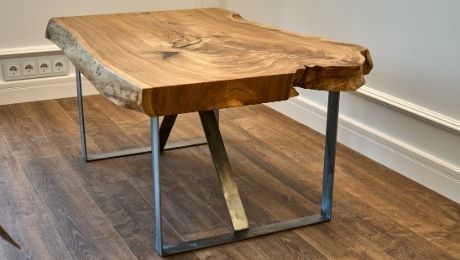
Carpentry Shop | Live Edge Wood Slab Projects
Share

If you’re bored with bland, mass-produced furniture pieces, you might be interested in the beautifully unique qualities of wood slabs. Wood slabs are large, rough, sawn pieces of wood that retain the original tree’s color, markings, and bark, providing a kind of rugged elegance. A slab is a rich, beautiful, and unique starting point for any number of projects, from desks to dining tables, and from conference tables to countertops. Here’s what to know about live edge wood slabs and their use and applications in furniture making.
What Are Live Edge Wood Slabs?
When you think of lumber, you probably think of the neatly sawn studs, planks, and boards you see stacked at the hardware store. And you're right, that is lumber; it’s indispensable to construction, hobbyists, and even furniture makers. However, it’s much different from the live-edge wood slabs we’re talking about here. The wood you see at the hardware store has been measured, cut, planed, sanded, and dried. Uniformity is the rule. Live-edge wood slabs (also known as flitches) are cut and dried as well, but the wood retains its natural shape, markings, and other elements, and the edges remain unfinished. What this means is no two wood slabs are alike and the furniture made from them is one of a kind. Pieces from the same tree share similar color, markings, and tones. Slabs or flitches that faced each other before cutting can be placed side by side, producing a mirror-like effect. This is called bookmatching since the wood resembles an open book. This can provide you with furniture that matches, but not in a redundant, manufactured way.
Where Do Live Edge Wood Slabs Come From?
Spoiler alert: trees! But what kinds? Which ones are best for which projects? The Carpentry Shop Co. carries or has carried slabs from ash, cherry, cedar, elm, maple, oak, walnut, and many others according to availability. The project type determines which wood is best for the job. Furnishings that face plenty of daily or rough usage—such as tables—should go with hardwoods such as walnut, maple, oak, and hickory. Softwoods like pine and spruce are better for things that see less use, like shelves and display tables. Crafty individuals with woodworking experience can often take such discarded pieces and turned them into glorious tables, desks, davenports, sideboards, and more, but it takes no small amount of skill to create live edge wood slab projects. Like any other kind of lumber, live edge wood slabs are prone to bend and curve. They require careful reworking and handling. As woodworking projects go, it’s a worthy goal, but it’s probably best left to the experts. A beautiful slab of wood can be badly damaged and lost in an amateur’s hands. Still, even an old, battered slab can be turned into a thing of beauty, because...
Nobody’s Nerfect
What makes wood slabs especially awesome are all their alleged “flaws”. Consider the Japanese principle of wabi-sabi, which recognizes beauty in imperfection, impermanence, asymmetry, and roughness. Not all trees are alike, but all are beautiful in their own way. Sometimes, furniture that seems imperfect at first glance can actually be exquisite. Naturally, some imperfections like cracks, knots, holes, and bark inclusions can’t be left in the wood. These are filled with epoxy color-matched to the wood before both are sanded down to a uniform level.
Recycled and Reclaimed
When learning what there is to know about live edge wood slabs, consider the fact that live edge wood slabs make good use of what others have traditionally cast off as “useless”. Originally, live edge wood furniture was favored and created by 19th century settlers who needed to build most of their worldly possessions by hand with whatever materials were available. Trees could be sawed into wood slabs, which were quickly converted into live edge wood slab projects such as rugged and long-lasting tables, chairs, beds, and other furnishings. Whether cut from trees or recovered as salvaged wood, slabs continue the worthy tradition of making do with what’s available and avoiding waste while still turning out items of tremendous use and beauty. Using discarded live edge wood also means fewer trees are being cut down, which is good for the environment and everyone in the long run.
Did You Know...?
One of the most well-known utilizers of live edge wood in his work was architect, woodworker, and furniture maker George Katsutoshi Nakashima. Born in Washington state, May 24, 1905, Mr. Nakashima earned his Master’s in architecture at MIT, and worked as an architect for many years. At one time he worked for Antonin Raymond, a contemporary of and collaborator with Frank Lloyd Wright. At some point in the 1940s, in Seattle, WA, began constructing furniture and taught woodworking. Sadly, like many Americans of Japanese ancestry during that time period, he was interned in a relocation camp in Idaho during the Second World War. Once there, he learned about traditional Japanese carpentry from fellow internee Gentaro Hikogawa. Nakashima loved and appreciated the natural look, shape, and beauty of live edge wood, and let every piece of wood “tell” him how to best craft it into furniture or other items. Today, original works by Mr. Nakashima can sell for tens of thousands of dollars. Consider the fact that any hand-crafted live edge wood slab furniture you might purchase could also rise in value over the decades.
Hopefully, this post has inspired you to consider appointing your own home or office with the luster, beauty, and all-natural artistry of live edge wood furniture. Take stock of your space and décor. Measure and assess the color scheme and layout of the room to see if it can handle the rustic charm of a gracefully rough piece of slab furniture. We offer a fine selection of handcrafted solid wood furniture, including several stunning examples wrought from live edge wood slabs. We also maintain a wide stock of various custom-cut hardwoods and softwoods for your own live edge wood slab projects and are available for commissions. Please explore our selection of furniture and live edge wood slabs to see what sort of ideas they spark in your own imagination!

